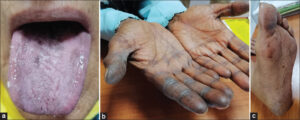Rare case of tongue hyperpigmentation with capecitabine
Ephraïm Lonté Kintossou , Kalil Cisse, Rhizlane Belbaraka
, Kalil Cisse, Rhizlane Belbaraka
Department of Medical Oncology, CHU Mohammed VI, University Cadi Ayyad, Marrakech, Morocco
Citation tools:
Copyright information
© Our Dermatology Online 2023. No commercial re-use. See rights and permissions. Published by Our Dermatology Online.
Hyperpigmentation of the tongue has been demonstrated by chemotherapy, particularly with cytotoxic drugs, yet the precise pathophysiological mechanism remains poorly understood [1].
Drug-induced pigmentation accounts for at least 20% of all cases of acquired pigmentation [2]. Antineoplastic agents have been demonstrated in the pigmentation of mucous membranes and nails [3].
Herein, we report the case of a 78-year-old patient followed for metastatic hepatic sigmoid ADK and carcinosis under capecitabine-type chemotherapy who presented grade II hand-foot syndrome (Figs. 1a and 1c) and hyperpigmentation of the tongue (Fig. 1b) after the third session of capecitabine. She was placed on symptomatic treatment with a one-week interruption in her treatment with improvement in the symptomatology. However, the hyperpigmentation failed to disappear completely; it persists yet in an attenuated manner.
 |
Figure 1: (a) Tongue hyperpigmentation after the third session of capecitabine, (b and c) Hand-foot syndrom grade II and hyperpigmentation after the third session of capecitabine. |
Such cases as this is a challenge for healthcare professionals and patients as they draw attention to the importance of documentation in improving patient care in the management of side effects associated with certain medications [1].
Consent
The examination of the patient was conducted according to the principles of the Declaration of Helsinki. The authors certify that they have obtained all appropriate patient consent forms, in which the patients gave their consent for images and other clinical information to be included in the journal. The patients understand that their names and initials will not be published and due effort will be made to conceal their identity, but that anonymity cannot be guaranteed.
REFERENCES
1. Lucia Moreira Gil, Joana Marques, Duarte Salgado. Hyperpigmentation de la langue associée au témozolomide en monothérapie:étude de cas. Port Acta Med. 3 février 2022.
2. Nahhas AF, Braunberger TL, Hamzavi IH. An update on drug-induced pigmentation. Am J Clin Dermatol. 2019;20:75-96
3. Casamiquela KM, Cohen PR. Chemotherapy-associated tongue hyperpigmentation and blue lunula. J Drugs Dermatol. 2013;12:223-6.
Notes
Request permissions
If you wish to reuse any or all of this article please use the e-mail (brzezoo77@yahoo.com) to contact with publisher.
| Related Articles | Search Authors in |
|
|




Comments are closed.